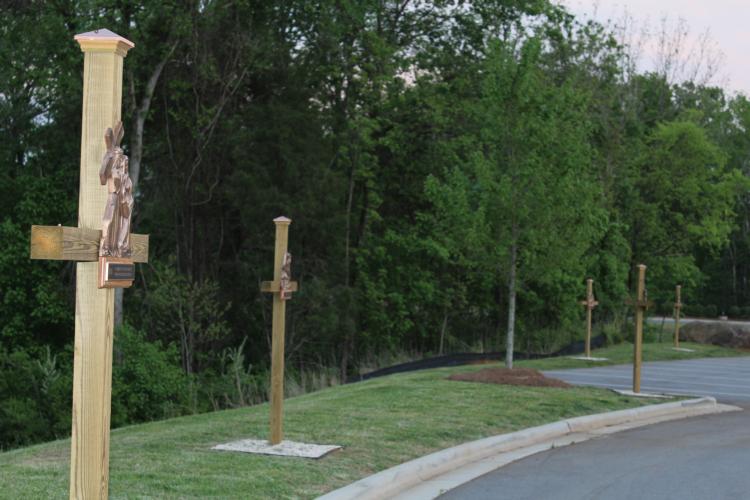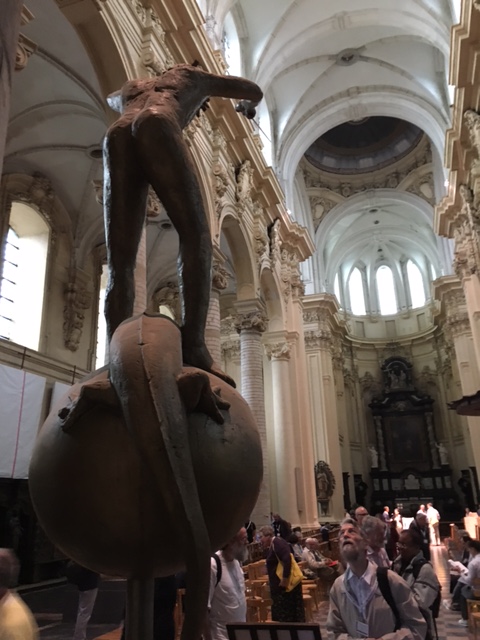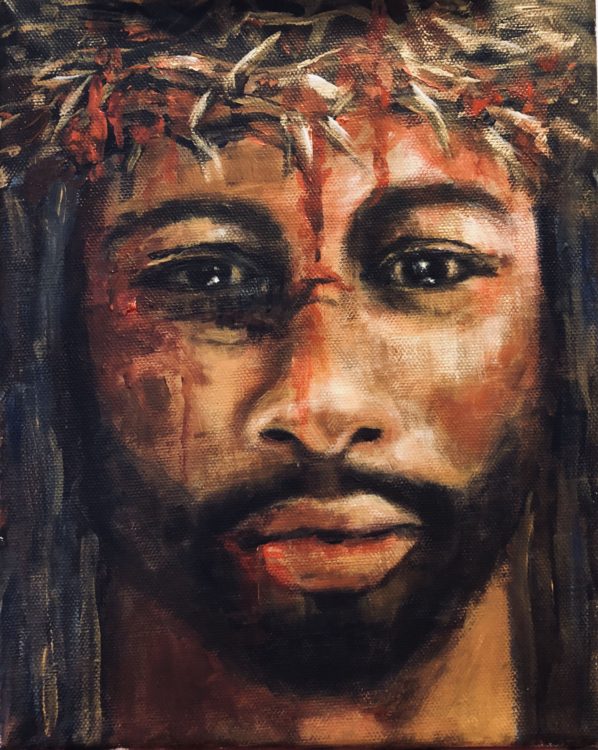Praying the Stations of the Cross is popular on the Fridays of Lent and especially on Good Friday. The practice goes back to the Crusaders in the Middle Ages who walked in Via Dolorosa, the way that Jesus walked from the judgment seat of Pontius Pilate to Golgatha outside the city walls. Christian pilgrims still walk this way in the old city of Jerusalem each year. It begins at the stone pillar where Jesus was whipped as Pilate’s way to satisfy the blood-lust of the crowd to the Church of the Holy Sepulchre which encloses the rock outcropped of Mount Calvary (Golgatha) where the crucifixion of Jesus is reported to have taken place. In imitation of Jesus carrying his cross. Pilgrims also carry a cross. Carrying a cross down the aisle of a church in the Good Friday Liturgy is also common, and a little Via Crucis brought indoors.
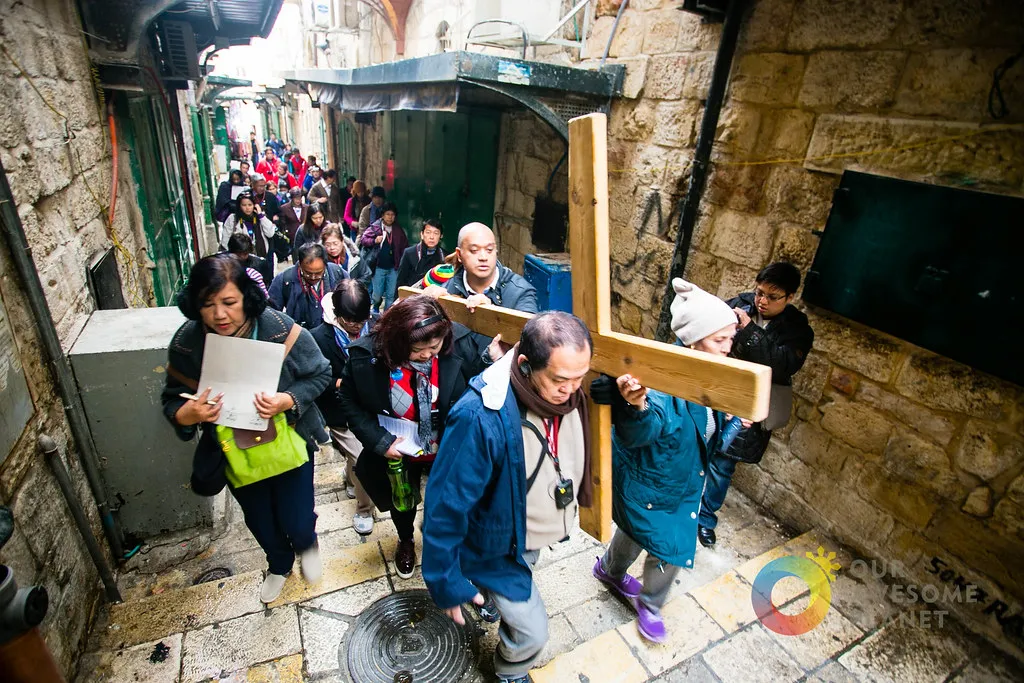
Christian pilgrims brought this practice of carrying the cross in a procession back to their own countries. It was especially promoted by the Franciscans. who wanted to make the life of Christ real for people. Today this pilgrimage is reenacted especially by Mexicans communities in he U.S. and by people influenced by Spanish-speaking Catholicism. This particular procession, called the Via Crucis (Way of the Cross) occurs in the Pilsen neighborhood in Chicago. It goes to a public park where the crucifixion of Jesus is reenacted.
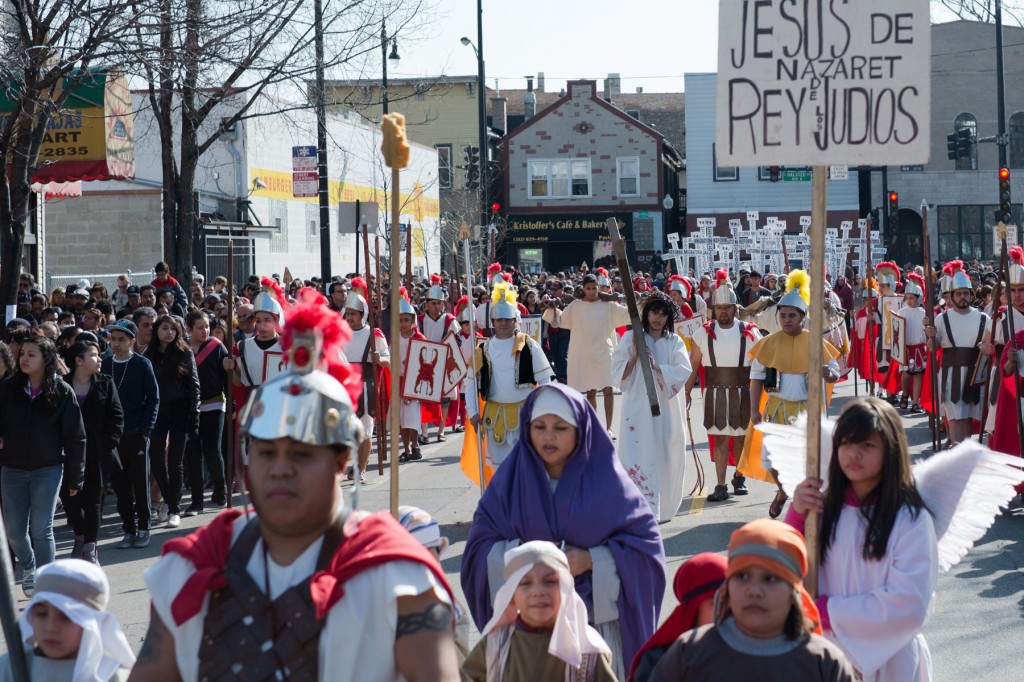
Via Crucis (Way of the Cross) in the Pilsen neighborhood of Chicago.
Among Franciscan devotions are the Stations of the Cross which may be spread out along an outside path (as in the image above this post) or shown in pictures mounted on the walls of a church building. While the number of stations varied, it has settled on fourteen. To this modern Catholicism has added a fifteenth station depicting the resurrection of Jesus. The Stations of the Cross is a paraliturgical devotion (a devotion beyond the liturgy) that may be prayed by a single person or by a group of any size. In a group stanzas of the 13th century hymn, Stabat Mater (“At the cross her station keeping/stood the mournful mother weeping/close to Jesus at the last”) ,are sung in the movement from station to station. At each stations a versicle and response is said.
V. We adore You, O Christ, and we praise You
R. Because by Your holy Cross, You have redeemed the world.
The Scripture text that relates to each station is read and a prayer follows. The prayer and other words spoken at each station may be free form. The Our Father and the Hail Mary prayers may be said. But the object of the station is to meditate on the picture for that station.
What follows are a variety of pictures by different artists for each station, some of whom have painted pictures for all fourteen stations..
I. Jesus is condemned to death.
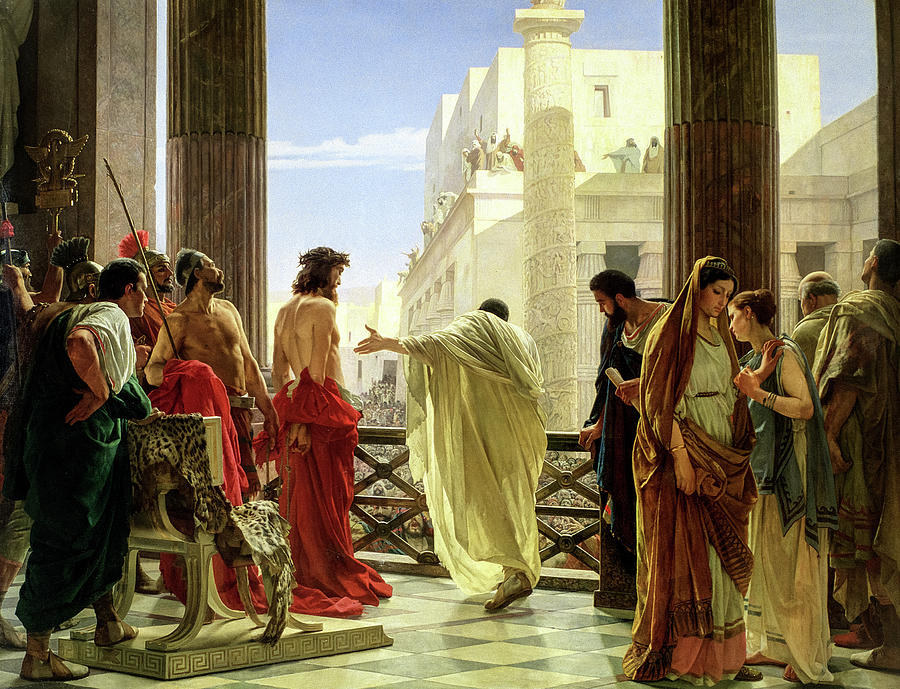
Jewish leaders turned over Jesus to the Roman governor, Pontius Pilate, for execution. He found nothing deserving death in Jesus, but had Jesus flagellated. The mob stirred up by the religious leaders cries for Jesus’ crucifixion. Pilate turns him over to the soldiers for crucifixion and washes his hands of the affair.
The suffering and death of Christ has been interpreted as a fulfillment of the suffering servant of Deutero-Isaiah. Isaiah 53:5 points to the possibility of the flogging of the suffering servant of God: “upon him was the punishment that made us whole, and by his bruises we are healed” (The King James version has: “by his stripes we are healed.”) The suffering servant has been interpreted as the nation of Israel. Israel bears the pains of the nations. Jesus the Messiah becomes Israel reduced to one. He bears the pain, the suffering, and the shame of the nations, including that of his own people Israel.
II. Jesus carries his cross.
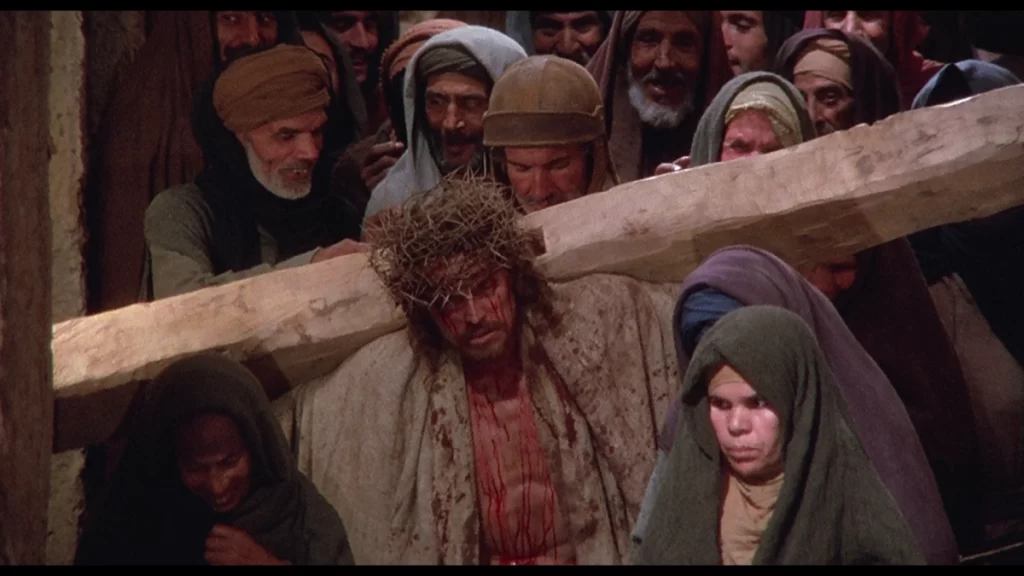
Willem Dafoe plays “Jesus” in Martin Scorsese’s1988 film of Nikos Kazantzakis’ novel, The Last Temptation of Christ. The film tried to be historically accurate. As such, the poles for crucifixion were already posted, Jesus carries the crossbeam.
III Jesus falls the first time.
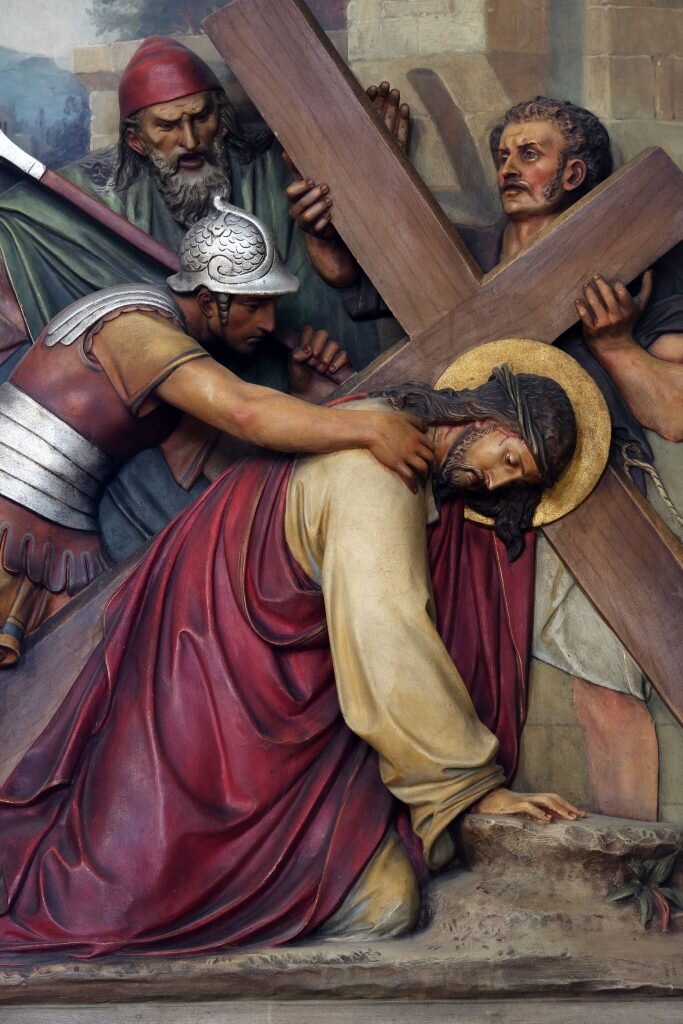
A traditional portrayal of Jesus in the stations wearing full inner and outer garments and carrying a full cross. But the crossbeam itself would be heavy and Jesus was weakened by his ordeal thus far: the trials before the Sanhedrin and Pontius Pilate and the flagellation.
IV. Jesus meets his mother.
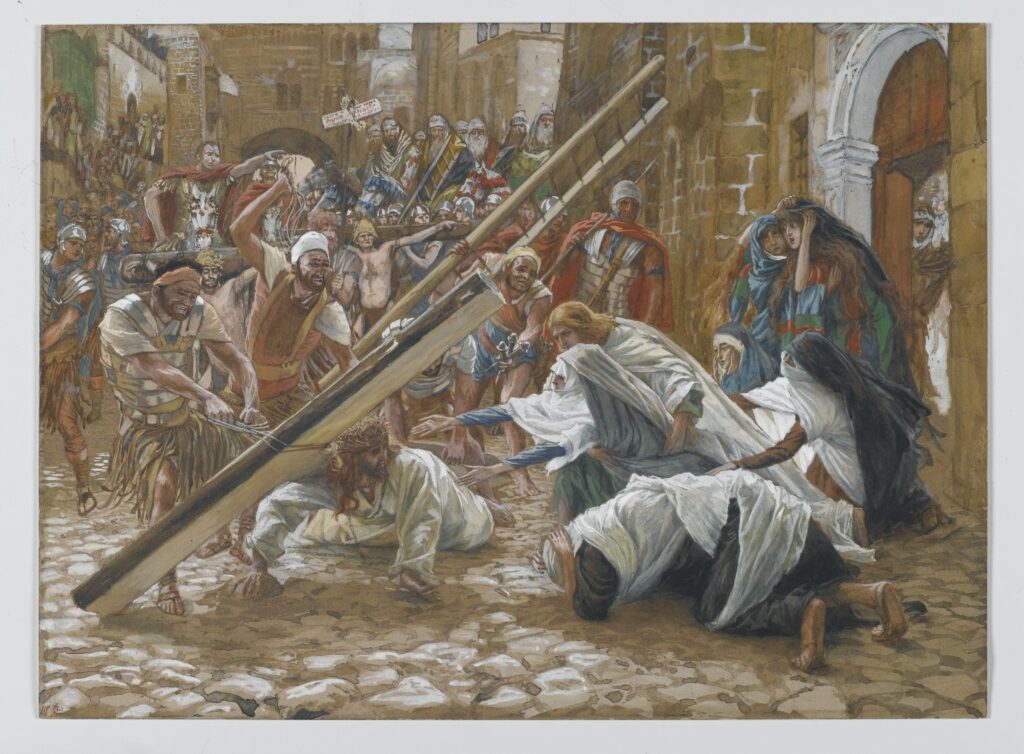
Although this episode cannot be found in the Gospel accounts, French artist James Jacques Tissot presents a scene traditionally included as one of the Stations of the Cross of Mary his Mother, after he falls while carrying his cross to Calvary. Mary’s cameo appearance in the Stations is appropriate since the Stabat Mater is sung during the movement from one station to the next. In the Passion according to St. John, which is read in the Good Friday Liturgy, Mary is at the foot of the cross with the Beloved Disciples. They are commended to the care of each other as mother and son.
V. Simon of Cyrene helps Jesus to carry his cross.
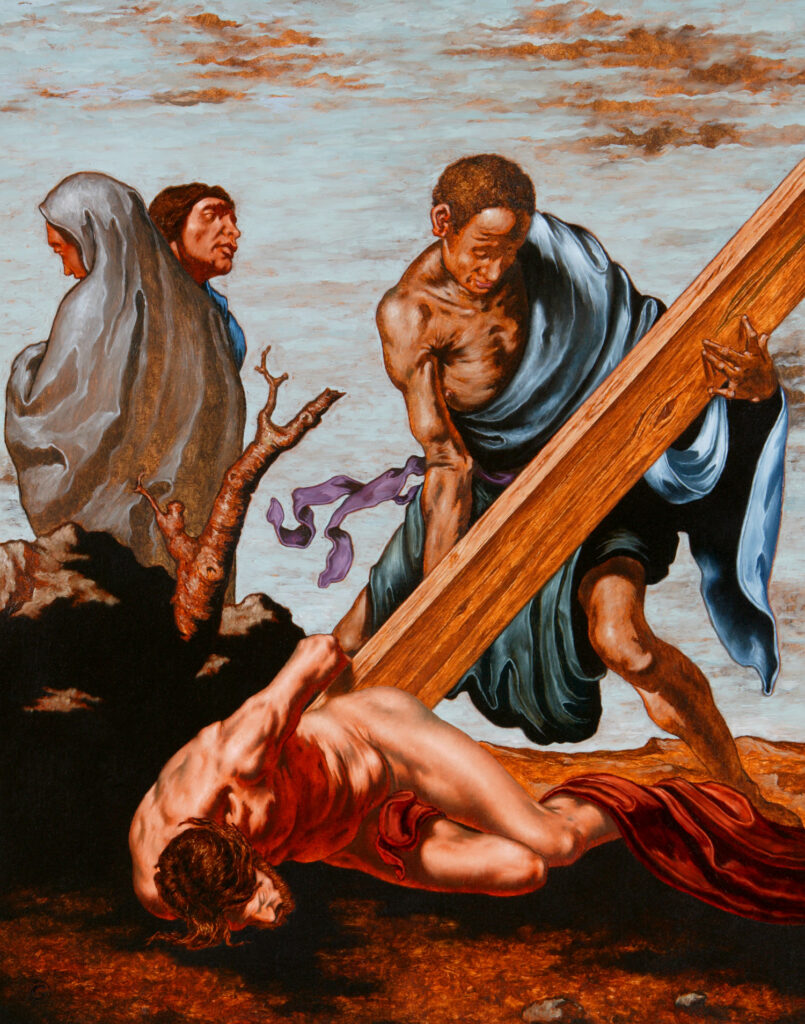
Simon of Cyrene, a visitor from out of town, is pressed into helping Jesus carry his crossbeam. Paintings for The Stations of the Cross – The Passion of The Christ in Art b y Randall Good were commissioned by the late Phil Cato in 1998. Mr. Cato wished to honor his family with the continued exhibit of the stations at St. Mark’s Episcopal Church in Hope, Arkansas. The artwork was permanently placed in 2011.
VI. Veronica wipes the face of Jesus
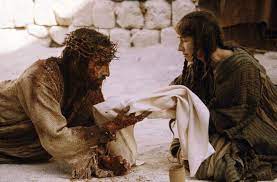
This scene from Mel Gibson’s film, The Passion of he Christ, is not biblically accurate. Early on a tradition developed of a woman who wiped the face of Jesus and she was given the Latin name “Veronica,” meaning “true face.” According to Church tradition, she was was moved with sympathy at the sight of Jesus carrying his cross and gave him her veil so that he could wipe his forehead. Jesus accepted the offer, and when he returned the veil the image of his face was miraculously captured on it. The veil was also miraculous retrieved as a relic.
VII. Jesus falls a second time.

Painting by Dan Radi. It captures the sense of utter exhaustion Jesus is experiencing as he carries his crossbeam.
VIII Jesus meets of women of Jerusalem
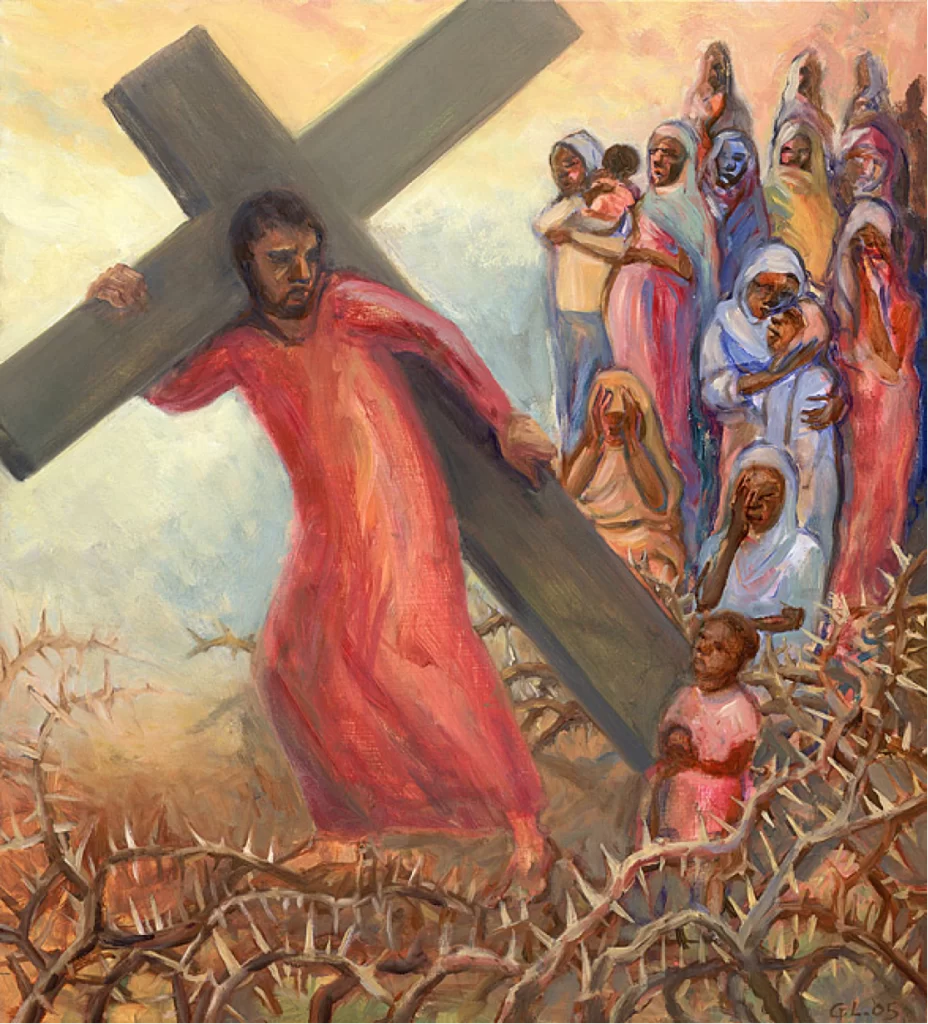
The set of Stations of the Cross at St. Mary’s Episcopal Church, Redbourne, AL are by the New York artist Gwyneth Leech. She has blended traditional Christian iconography with contemporary elements by incorporating the suffering and grief of people around the world. Jesus turns a compassionate look at the women of Jerusalem, but admonishes them to “weep not for me, but weep for yourselves and for your children” (Luke 23:28). He prophesies that worse days are coming.
IX. Jesus falls a third time.
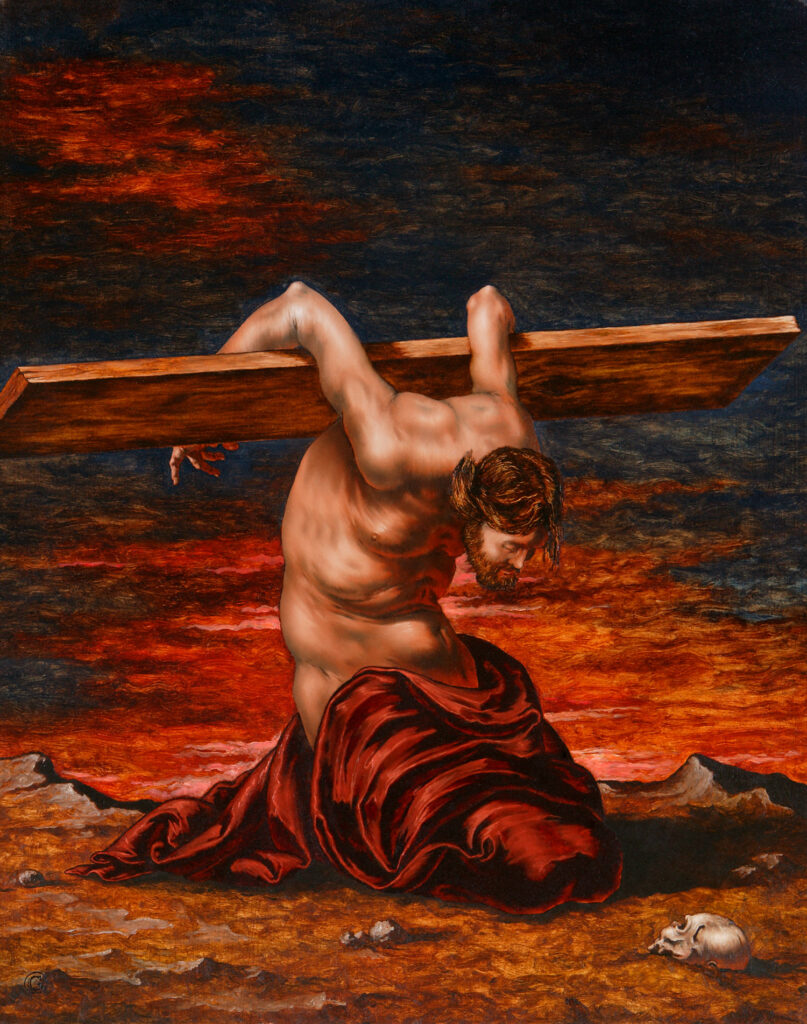
The artist Randall M. Good sees a profound gravitas occurring as the journey to the place of the skull (Golgatha) nears its end. Jesus sinks down into the earth, which is the final resting place of all humanity.
X. Jesus is stripped of his clothing.

Romans crucified their victims naked to increase their sense of humiliation. Jesus’ clothes will be divided among the soldiers and they will cast lots for his robe. This is how Gweneth Leech made the scene more contemporary. Notice the soldiers and the police dogs.
XI. Jesus is nailed to the cross.
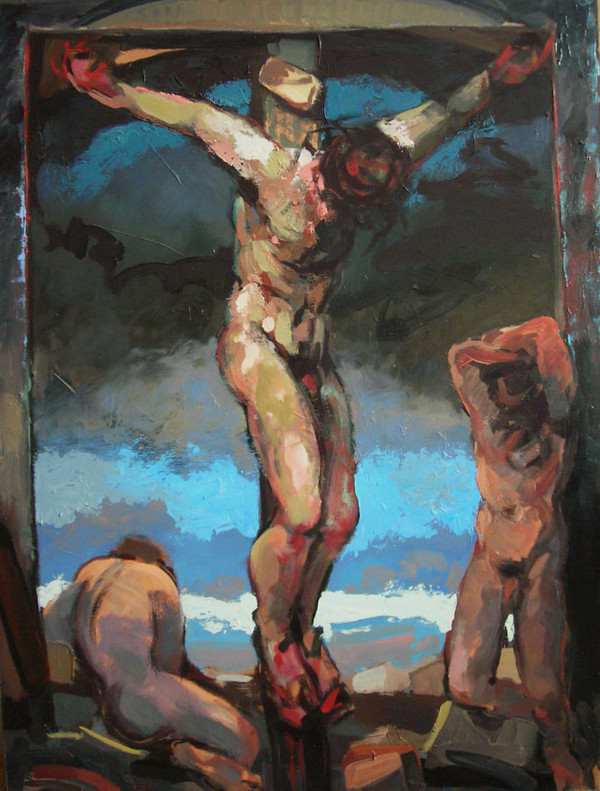
“Crucifixion” by Edward Knippers. Here Jesus and the two bandits who will be crucified with him are prepared to be lifted up naked on the tree of the cross.
This crucifixion scene by German artist Michael Trieger shows Jesus crucified among many crosses. From the Gospel of John his Mother and the Beloved Disciple are at the foot of thee cross.
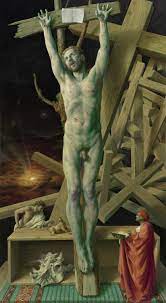
XII. Jesus dies on the cross.
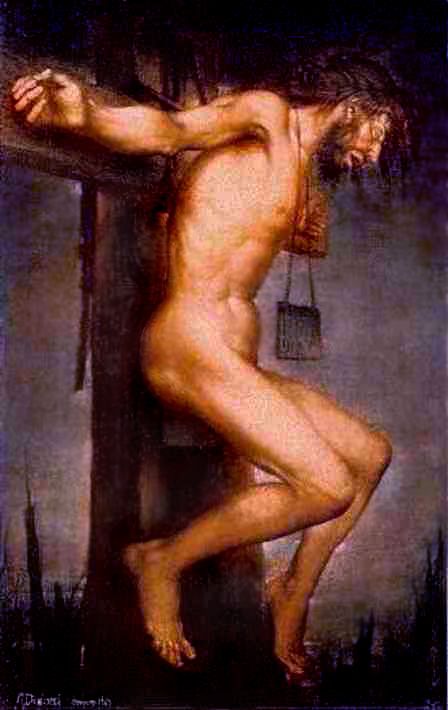
“Crucifixion” by Mario Donizetti (in the Vatican Museum). This is an attempt to show the realism of death on the cross. The sign of the charge is hung from the victim’s neck. The charge against Jesus was that he was “king of the Jews,” which Pilate had written in Latin, Greek, and Hebrew, so that it would be noted by all who passed by. The small platform on which Jesus rests to keep him from falling forward makes the cross a kind of throne. Archaeological evidence shows that victims were nailed through their ankles, not through the tops of their feet. Likewise, they were nailed through their wrists, not through their hands.
XIII. The body of Jesus is taken down from the cross.
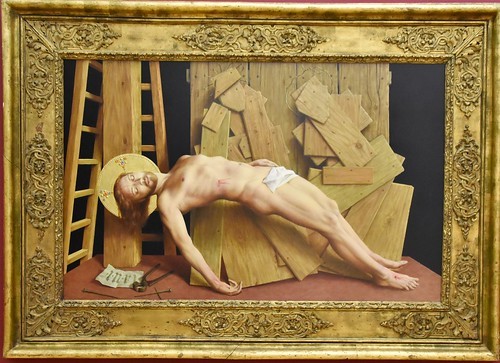
“The Deposition of Christ” by Michael Triebel
The pieces of wood in the carpenter shop suggest the Pieta, in which the dead son lies in lap of his mother. The pieta invites us to meditate on this moment of tenderness and grief. Perhaps the artist wonders if we are capable of such sentiment.
XIV. Jesus is laid in the tomb.
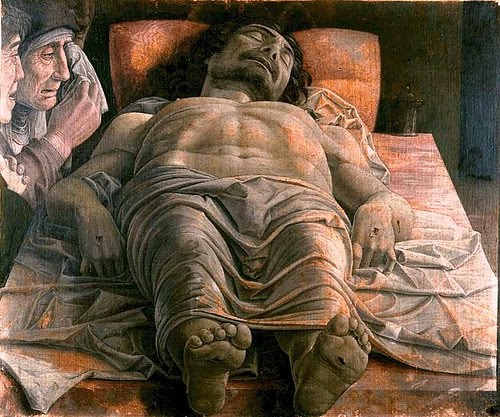
“The Dead Christ” by Andreas Mantegna (1490)
According to St. John’s passion narrative the Jewish leaders did not want the bodies of the crucified victims left on the crosses because it was getting toward the Eve of the Sabbath, a great Sabbath that year because it was also Passover. The soldiers were instructed to break the legs of the crucified to hasten their death. They discerned that Jesus was already dead and made sure of it by thrusting a spear into his side, which released a gusher of blood and water.
Securing permission from Pilate to retrieve the body of Jesus, two hidden disciples of Jesus, Joseph of Arimathea and Nicodemus, took the body down from the cross and carried it to a nearby garden where there was a new tomb, never before used. They did what they could with the body and departed. The women followers of Jesus who went with the men carrying Jesus’s body would return on the morning of the first day of the week to anointing the body for a proper burial. The dead body of Jesus lays on the slab during his own sabbath rest on the threshold of his own completed passover from death to life.
From the Eve of Holy Saturday (Good Friday night) to the Eve of Easter (Holy Saturday night) a great sabbath descends on the liturgical life of the church. This reenacts the Great Sabbath of the year Jesus died when it was necessary to hurry his death (the spear thrust into his side), remove his body from the cross and get it into a borrowed tomb for a hurried burial before the Sabbath began. There is a liturgical pause between Good Friday and Easter that gives us an opportunity to ponder both Jesus’ death and and his resurrection that we will celebrate. But by moving too quickly from the cross to the empty tomb, we fail to grasp the depths of Jesus’ suffering and death; what it means that God suffered and died that day. Nor can we know the wonder, power, and hope of “He is risen! Alleluia” unless we feel the full weight of God lying lifeless in the grave during an interval of utter despair when no such hope was even conceivable for Jesus’s followers — or for us, if we are honest. Therefore, I do not include here the new fifteenth station of the resurrection.
Pastor Frank Senn, STS
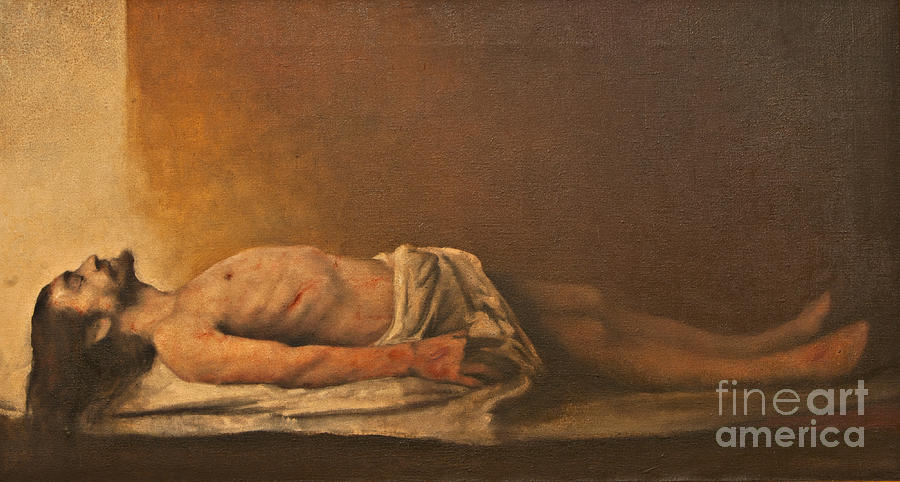
Jesus lies in the tomb. Painting by Dan Radi.

